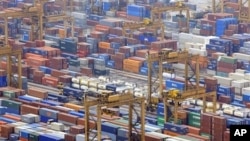The United States and the other eight nations in the Trans-Pacific Partnership are making significant progress toward concluding a comprehensive trade agreement, Deputy U.S. Trade Representative Demetrios Marantis said recently in Washington.
Singapore, New Zealand, Chile, and Brunei concluded a high-standard agreement in 2006 on which the Trans-Pacific Partnership is based, and sought to expand the agreement, which now also includes the United States, which joined in late 2009, as well as Australia, Malaysia, Peru, and Vietnam. Mexico and Canada have been invited to join and will enter negotiations soon.
The trade agreement under negotiation aims to support the creation and retention of jobs in the Trans-Pacific Partnership countries, strengthen Asia-Pacific relations, and eventually create a free-trade area across the region. Ambassador Marantis noted that through this agreement, the United States is seeking to set ambitious trade standards, including ensuring worker rights and protecting the environment.
Heading into the 14th round of negotiations, to be held September 6–15 in Leesburg, Virginia, the Trans-Pacific partners will continue their work to develop a comprehensive agreement that covers not only the trading of goods, but also of traditional and emerging services. In addition, they will focus on addressing nontariff trade barriers by, among other things, promoting regulatory clarity and coherence.
The Trans-Pacific Partnership members will also focus on how to better integrate small- and medium-sized enterprises into global trade. Calling these businesses “the backbone of our economy,” the primary source of jobs in the United States and the largest group of U.S. exporters, Ambassador Marantis said their participation in regional trade under the agreement will add significant value for all the partners.
The Asia-Pacific Partners will also negotiate on new issues that businesses and workers face in the digital age. The United States is seeking to ensure the free flow of information on the Internet and to obligate countries to strike a balance between copyright protections and fair use for reporting, research and scholarship.
The United States has put forward a conservation proposal that seeks to address illegal trade in wildlife, logging and fisheries, which will be a first in a trade agreement.
“We are on track to realizing the dream of the Trans-Pacific Partnership,” Ambassador Marantis said, “a high-standard, 21st-century agreement that serves as the platform for regional integration in the Asia-Pacific.”
U.S. Trans-Pacific Partners Move Toward Trade Deal

U.S. and eight other nations making significant progress toward concluding a comprehensive trade agreement.












